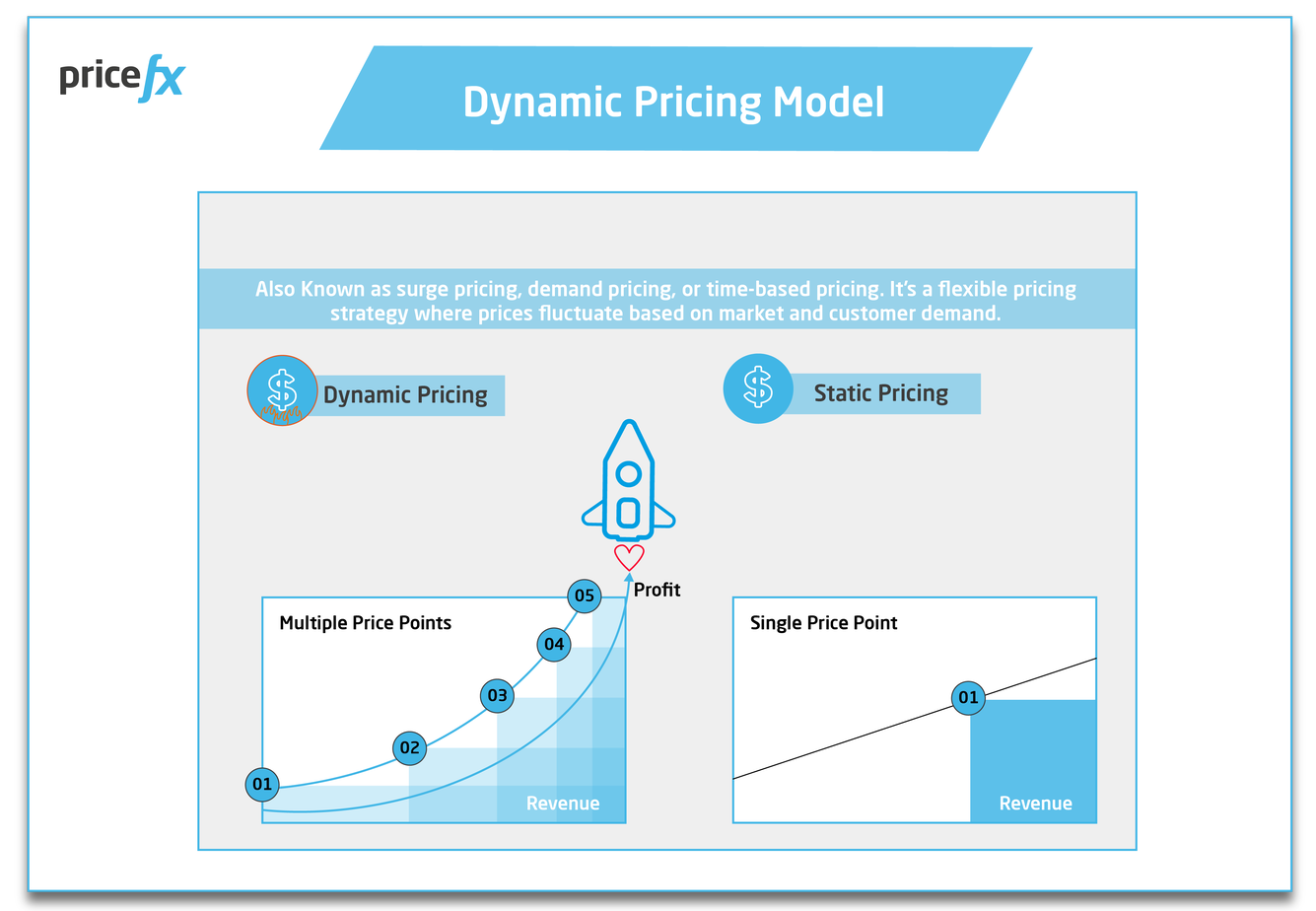Moving to Dynamic Pricing: How to Prepare Your Company
December 18th, 2023 | 10 min. read
By Adam Pomothy
Congratulations on making the strategic decision to embrace dynamic pricing for your company. The potential benefits and revenue opportunities that come with moving to dynamic pricing are immense. However, now comes the crucial phase of preparing your company for the migration. Understanding where to begin and how to navigate this transformative journey can seem daunting. And if you are not ready, the possibility of not maximizing dynamic pricing to its absolute fullest capacity ASAP might feel as bad as making a loss.
At Pricefx, we have more than a decade of assisting companies to implement their unique and customized pricing strategy projects informed by pricing software. Based on our experience, no lever has more importance in unearthing each individual organization’s pathway to profit than pricing does.
In this article, we will guide you through the essential steps and provide valuable insights on how to effectively prepare your company for the transition to dynamic pricing. From assessing your current pricing infrastructure to implementing the right tools and strategies, we will equip you with the knowledge and guidance needed to navigate this exciting transformation successfully.
So, let’s dive in and ensure your company is fully prepared to unlock the full potential of dynamic pricing. First up, what is dynamic pricing exactly?
Dynamic Pricing Explained
Dynamic pricing is a pricing strategy that involves adjusting prices in real-time based on a range of factors such as demand, market conditions, competition, and customer behavior.

Unlike traditional static pricing models, dynamic pricing enables companies to set prices that reflect the true value of their products or services at any given moment.
By leveraging data analytics and advanced algorithms, businesses can optimize their pricing strategies to maximize revenue, improve profitability, and respond swiftly to market dynamics.
So, let’s dig into the meat of topic on the intricacies of dynamic pricing and explore how your company can prepare for this innovative approach to pricing.
Dynamic Pricing for the Future – Start by Honestly Assessing Your Present
As pricing software technology continues to revolutionize the business landscape, dynamic pricing has emerged as a powerful strategy to optimize profit and other desired business outcomes, respond to market fluctuations, and stay ahead of the competition. However, making this transition requires careful planning, strategic decision-making, and the right tools to ensure a smooth and successful implementation. Naturally, the importance of automated pricing software solutions and providing actionable insights to help you navigate this transformation with confidence but there are steps to negotiate beforehand;
1. Honestly Assess Your Current Pricing Infrastructure
Before diving into the world of dynamic pricing, it is crucial to take an honest look at your current pricing infrastructure. Assessing your existing processes, systems, and data will provide a solid foundation for the transition. Start by evaluating how pricing decisions are currently made within your organization. Are they primarily based on intuition, cost-plus models, or fixed pricing? Understanding the limitations and challenges of your current approach will help you identify areas that need improvement.
Next, consider the tools and technologies you have in place to support your pricing operations. Are you still relying on spreadsheets or manual calculations? Such methods are prone to human error and lack the agility required for dynamic pricing. This is where an automated pricing software solution comes into play. It enables you to streamline your pricing processes, leverage data-driven insights, and respond swiftly to market changes. Assessing your pricing technology landscape will reveal gaps that need to be addressed to enable a successful transition.
Additionally, evaluate the quality and accessibility of your pricing data. Are you capturing and analyzing relevant data points such as customer behavior, competitor pricing, and market trends? If not, it’s time to enhance your data collection and analysis capabilities. Implementing robust data infrastructure and analytics tools will empower you to make informed pricing decisions based on real-time insights. Remember, dynamic pricing relies heavily on accurate and up-to-date data, so investing in data capabilities is essential for success.
By honestly assessing your current pricing infrastructure, you lay the groundwork for a smooth transition to dynamic pricing. Identifying areas for improvement and addressing gaps in technology and data will set the stage for implementing a more agile and data-driven pricing strategy.
Remember, this assessment is not meant to criticize your current practices but rather to identify opportunities for growth and improvement. With a clear understanding of your starting point, you can confidently move forward in preparing your company for the exciting world of dynamic pricing.
2. Define Your Pricing Objectives (Based on Your Business Goals)
Clearly define your pricing objectives based on your business goals, market dynamics, and customer preferences. Determine whether your focus is on plugging margin gaps. maximizing revenue, gaining market share, or optimizing customer satisfaction. This clarity will guide your pricing strategy and ensure that your dynamic pricing efforts are aligned with your overall business objectives.
3. Invest in Data-Driven Automated Pricing Software
Dynamic pricing is heavily reliant on data analysis to make informed pricing decisions. To effectively prepare your company for the transition, it is crucial to invest in data-driven automated pricing software. This will enhance your data collection and analysis capabilities, allowing you to gain valuable insights into customer behavior, market trends, and competitor pricing to establish a solid foundation for implementing dynamic pricing strategies.
Automated pricing software empowers your company to collect and process large volumes of data efficiently. It can integrate with various data sources, such as customer databases, sales transactions, market data, and competitor information. This enables you to extract meaningful insights and patterns that inform your pricing decisions. By utilizing advanced algorithms, the software can analyze historical data, identify pricing trends, predict future market dynamics, and even feed the software’s insights and results back into other systems like your SAP, Salesforce and other CRM and ERP systems.
What’s more, data-driven automated pricing software enables real-time monitoring of market conditions and customer preferences. This allows you to adjust prices dynamically based on demand fluctuations, competitor actions, and other relevant factors. The software provides you with the agility to respond swiftly to market changes and optimize your pricing strategies accordingly.
Investing in data-driven automated pricing software not only enhances your analytical capabilities but also streamlines your pricing processes. With automated data collection and analysis, you can eliminate manual errors and save valuable time. The software generates accurate pricing recommendations based on predefined rules, pricing models, and your desired business objectives. It empowers your pricing team to focus on strategic decision-making rather than mundane administrative tasks.
4. Develop a Pricing Strategy Combinations ‘Wishlist’
When preparing your company for the transition to dynamic pricing, it is essential to develop a comprehensive pricing strategy combination wishlist. While dynamic pricing will be a key component, it is important to understand that it can happily coexist with other pricing strategies to achieve your desired outcomes. Developing a pricing strategy combination wishlist allows you to leverage various pricing strategies in harmony with dynamic pricing.
Start by incorporating segmentation into your pricing strategy. Analyze your customer base and identify different customer segments based on their preferences, behavior, and willingness to pay. By tailoring your prices to specific segments, you can maximize revenue and customer satisfaction. Utilize your automated pricing software solution to implement dynamic pricing within each segment, considering factors such as product preferences, purchasing history, and market demand.
Another important aspect to consider is competitive analysis. Keep a close eye on your competitors’ pricing strategies and market positioning. Use your pricing software to gather real-time data on competitor prices, promotions, and discounts. By understanding how your competitors are pricing their products, you can adjust your dynamic pricing strategy accordingly to remain competitive while maximizing your profitability.
Pricing elasticity is another valuable component to include in your pricing strategy combination. Assess how sensitive your customers are to price changes and determine the optimal price points that maximize revenue. Your pricing software can help you analyze past sales data and conduct pricing experiments to measure price elasticity and identify revenue-optimized price points.
Lastly, consider incorporating value-based pricing into your strategy. Understand the unique value proposition of your products or services and set prices accordingly. Aligning your prices with the perceived value your customers receive can increase their willingness to pay and drive higher profits. Your automated pricing software can help you capture customer feedback, conduct market research, and analyze customer preferences to determine the optimal value-based pricing strategy.
By utilizing your automated pricing software solution, you can implement different models, continuously monitor market dynamics, and fine-tune your strategy based on customer feedback. This comprehensive approach will enable your company to navigate the dynamic pricing landscape successfully and achieve your desired pricing outcomes.
5. Train & Align Your Team
Prepare your team for the transition to dynamic pricing by providing comprehensive training on the new pricing approach and the automated pricing software solution. Foster a culture of data-driven decision-making, encourage collaboration across departments, and ensure that all stakeholders understand the benefits and impact of dynamic pricing on the organization’s success.
Get your staff involved in whatever training you wish to make any changes your organization requires to become pricing self-sufficient.
6. Monitor, Measure, and Adapt
Implement robust monitoring and measurement mechanisms to evaluate the effectiveness of your dynamic pricing strategy. Leverage the capabilities of your automated pricing software to track key performance indicators, customer responses, and pricing outcomes.
Analyze the data regularly and make data-driven adjustments to continuously optimize your pricing strategy.
Be Agile – Keep Learning & Adapting – Pricing is a Non-Stop Commitment
By following these defined steps above and leveraging the power of an automated pricing software solution, you can confidently prepare your company for the transition to dynamic pricing. Embrace the opportunities it presents to enhance profitability, respond to market dynamics, and deliver value to your customers.
Remember, the journey towards dynamic pricing is a continuous process of learning and improvement. Stay agile, adapt to changing market conditions, and embrace innovation to thrive in today’s dynamic business landscape.
Automated pricing software solutions can optimize your products at different channels and locations, including tracking a myriad of factors including shopping history, competitor pricing, past sales volumes, and supplier pricing. When your business has access to intelligent pricing insights like these, it will make your organization’s dynamic pricing strategy a much more targeted and profitable precision pricing tool.
AI-informed pricing software like Pricefx can assist your business to put in place a dynamic pricing strategy or range of alternative pricing strategies based on your company’s precise set of business outcomes.
But what if you do not have pricing software and/or do not intend to invest in it? To learn more about how much it might be costing your business – right now – by not using price pricing software, check out this handy article – The Cost of Inertia (Not Using Pricing Software)
Looking at things more positively, check out our Margin Lift Calculator by clicking on the link below to see how much a pricing software solution could add to your organization’s bottom line:
Happy Pricing!



